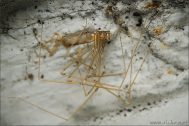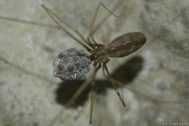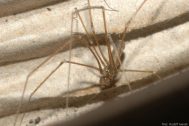| Nálezy podle období | |||||
|---|---|---|---|---|---|
| Pholcidae | 0-1900 | 1901-1950 | 1951-2000 | 2001+ | ∑ |
| Pholcus opilionoides (Schrank, 1781) Není ohrožený | 4× | 8× | 184× | 91× | 287× |
Pholcus opilionoides (Schrank, 1781)
| České jméno | třesavka sekáčovitá |
|---|---|
| Stupeň ohrožení | Není ohrožený |
| Nálezy | 287 nálezů, 118 kvadrátů |
| První nález |
1859, F. Prach, Prach 1866 |
| Poslední nález | 2025 , Ondřej Machač |
| Areál rozšíření | Holarctic |
| Fytogeografická oblast | - |
| Původnost stanovišť |
|
| Vlhkost stanovišť |
|
| Stratum |
|
| Osvětlení stanovišť |
|
| Hojnost výskytu |
|
| Nadm. výška | 150-900 |
Literatura
Pholcus alticeps ve volné přírodě
Two records of Pholcus alticeps species outside the interior spaces of buildings are presented here.Karyotype differentiation and male meiosis in European clades of the spider genus Pholcus (Araneae, Pholcidae).
Haplogyne araneomorphs are a diverse spider clade. Their karyotypes are usually predominated by biarmed (i.e., metacentric and submetacentric) chromosomes and have a specific sex chromosome system, X1X2Y. These features are probably ancestral for haplogynes. Nucleolus organizer regions (NORs) spread frequently from autosomes to sex chromosomes in these spiders. This study focuses on pholcids (Pholcidae), a highly diverse haplogyne family. Despite considerable recent progress in pholcid cytogenetics, knowledge on many clades remains insufficient including the most species-rich pholcid genus, Pholcus Walckenaer, 1805. To characterize the karyotype differentiation of Pholcus in Europe, we compared karyotypes, sex chromosomes, NORs, and male meiosis of seven species [Pholcus alticeps Spassky, 1932; P. creticus Senglet, 1971; P. dentatus Wunderlich, 1995; P. fuerteventurensis Wunderlich, 1992; Pholcus phalangioides (Fuesslin, 1775); Pholcus opilionoides (Schrank, 1781); P. silvai Wunderlich, 1995] representing the dominant species groups in this region. The species studied show several features ancestral for Pholcus, namely the 2n♂ = 25, the X1X2Y system, and a karyotype predominated by biarmed chromosomes. Most taxa have a large acrocentric NOR-bearing pair, which evolved from a biarmed pair by a pericentric inversion. In some lineages, the acrocentric pair reverted to biarmed. Closely related species often differ in the morphology of some chromosome pairs, probably resulting from pericentric inversions and/or translocations. Such rearrangements have been implicated in the formation of reproductive barriers. While the X1 and Y chromosomes retain their ancestral metacentric morphology, the X2 chromosome shows a derived (acrocentric or subtelocentric) morphology. Pairing of this element is usually modified during male meiosis. NOR patterns are very diverse. The ancestral karyotype of Pholcus contained five or six terminal NORs including three X chromosome-linked loci. The number of NORs has been frequently reduced during evolution. In the Macaronesian clade, there is only a single NOR-bearing pair. Sex chromosome-linked NORs are lost in Madeiran species and in P. creticus. Our study revealed two cytotypes in the synanthropic species Pholcus phalangioides (Madeiran and Czech), which differ by their NOR pattern and chromosome morphology. In the Czech cytotype, the large acrocentric pair was transformed into a biarmed pair by pericentric inversion.
Inventarizační arachnologický průzkum části Havranického vřesoviště (Národní park Podyjí)
Klub mladých přírodovědců (KMP) při ZOO Praha, zájmový útvar pro středškolskou a vysokoškolskou mládež pořádá v rámci svého programu každoročně v období prázdnin (červenec - srpen) ekologický kurz. Úkolem kurzu je ověřit si získané poznatky a získat další zkušenosti s vědeckou prací.
V tomto roce se kurz konal v Národním parku Podyjí, kde jsme prováděli inventarizační průzkum vybrané lokality z hlediska botanického i zoologického. Součástí programu kurzu bylo i vypracování zprávy o výsledcích růzkumu, která bude poskytnuta k dalšímu zpracování správě NP Podyjí.
Fotografie
Statistiky
Dle měsíce v roce
Dle nadmořské výšky
Dle metody sběru (285 použitých nálezů)
| Pholcus opilionoides (Schrank, 1781) ES | Samci | Samice | Mláďata | Nálezy |
|---|---|---|---|---|
| Pozorování | 7 | 11 | 5 | 12 |
| Neurčeno | 12 | 28 | 13 | 73 |
| Individuální sběr | 50 | 88 | 38 | 114 |
| Fotografie | 1 | 7 | 15 | 3 |
| Zemní past | 39 | 36 | 24 | 63 |
| Prosev | 1 | 4 | 5 | 9 |
| Smyk | 5 | 8 | 2 | 10 |
| Sklepávání | 0 | 2 | 0 | 1 |
| Samci | Samice | Mláďata | Nálezy |
Dle biotopu (286 použitých nálezů)
| Pholcus opilionoides (Schrank, 1781) ES | Samci | Samice | Mláďata | Nálezy |
|---|---|---|---|---|
| Vnější stěny budov | 8 | 17 | 0 | 15 |
| Neurčeno | 18 | 37 | 19 | 91 |
| Louky | 1 | 1 | 0 | 1 |
| Antropická společenstva | 1 | 1 | 16 | 3 |
| Interiéry budov | 12 | 31 | 13 | 34 |
| Ruderály | 3 | 4 | 1 | 6 |
| Stinné skály nižších poloh | 0 | 2 | 1 | 3 |
| Suché lesní lemy | 0 | 1 | 0 | 1 |
| Skalní a suťové biotopy | 0 | 1 | 1 | 2 |
| Těžebny písku a jiných nezpevněných hornin | 2 | 0 | 0 | 2 |
| Výsadby jehličnanů | 0 | 1 | 0 | 1 |
| Výsadby listnáčů | 0 | 1 | 0 | 1 |
| Zahrady | 0 | 0 | 0 | 2 |
| Kamenité suti nižších poloh | 32 | 48 | 33 | 58 |
| Kamenolomy | 18 | 18 | 5 | 21 |
| Vřesoviště nižších poloh | 2 | 2 | 0 | 3 |
| Suché křoviny | 1 | 0 | 0 | 1 |
| Suťové a roklinové lesy | 3 | 0 | 0 | 2 |
| Haldy a výsypky | 2 | 2 | 0 | 2 |
| Mokřady | 0 | 1 | 0 | 1 |
| Louky a pastviny | 0 | 0 | 1 | 1 |
| Porosty borůvek | 0 | 1 | 0 | 1 |
| Suché louky | 5 | 4 | 6 | 13 |
| Rašeliniště | 0 | 1 | 0 | 1 |
| Luční ostřicové mokřady | 0 | 1 | 0 | 1 |
| Xerotermní travinobylinná společenstva | 1 | 3 | 0 | 2 |
| Lesy vyšších poloh a strmých svahů | 0 | 0 | 1 | 1 |
| Suché doubravy | 0 | 1 | 0 | 1 |
| Skalní stepi na vápenci | 4 | 1 | 3 | 9 |
| Pozemní komunikace | 2 | 0 | 0 | 1 |
| Ovocné sady s luční vegetací | 0 | 3 | 0 | 1 |
| Lesní okraje | 0 | 1 | 1 | 2 |
| Dubohabřiny | 0 | 0 | 1 | 1 |
| Zahradnicky utvářené zahrady a parky | 0 | 1 | 0 | 1 |
| Samci | Samice | Mláďata | Nálezy |

























